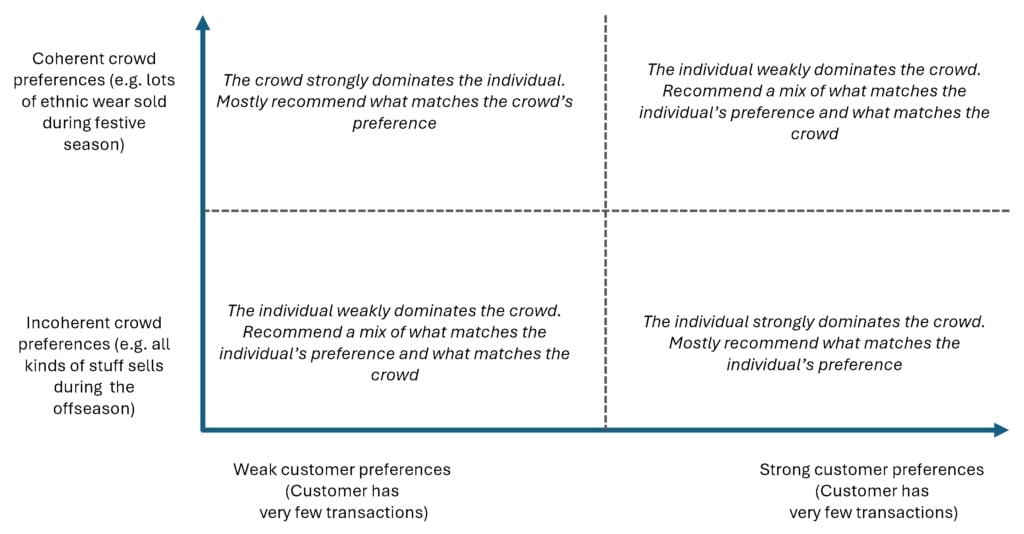Source : wikipedia.org
Imagine you’re a bartender in a small village in the wild west. On one dull Thursday afternoon, you’re sitting there minding your own business and a tall blond man with a poncho, cowboy hat, cigar and visible gun belt walks in. You’ve never seen this man before but you’re immediately worried.
Not because you think the bullets are gonna start flying but simply because, well, you’re very good at talking to people you know and here’s a guy who is, in the most literal sense of the term, anonymous.
Which brings us to the topic of today’s blog: how do you personalize your interactions with customers you haven’t seen before? Or – let’s extend this a bit further – how about customers you’ve seen very little of?
When you hear people talk about personalization, what you typically hear is the dream scenario: We track our customers’ digital footprint on our app and other partner websites/apps, and this gives us a complete picture of their likes and dislikes, and can therefore recommend the right product to them at the right time.
The trouble is, if you’re a business whose business is largely offline, and the only thing you see is the customer’s actual transaction behaviour, and over half your customers have visited your store only once… you get the picture.
By and large, the solution to this problem is pretty intuitive.
- Trust the crowd: Where you know little to nothing about the customer per se, but plenty about the population, start with what the crowd wants. The trick is to gradually scale down the influence of the population as you know more about the individual.
- KYC: Sometimes, in industry verticals like BFSI, you have socio-demographic information such as age, gender, marital status, education, occupation, income and location. Now, slice-and-dice by these features and figure out what works.
- Explore vs Exploit: Even when you know very little about the customer, you might still have multiple strategies available. How do you know which one works? You test and learn. The more you learn, the less you have to test, but as mentioned in the earlier post about testing on demand, keep the door open to discovery, always.
- Learn from intent as much as from action: Maybe your business is still largely offline. In this day and age, you’re still likely to have a website or app. Embed a link in your outreach efforts and track the click-through rates. Your customer might still prefer to buy from the store, but the fact that they clicked and viewed the personalized content you put up is still a statement of intent, and can be considered a weak positive signal.
All this is well and good, but how to translate this into concrete solutions? Here’s what SOLUS offers.
Recommended strategies
It is possible to deploy anonymized recommender strategies of various kinds.
The most obvious one is Trending, wherein you’re simply recommending what most people buy. However, it is also possible to break this down by location, gender etc. What you’re basically doing here, is mixing a generic strategy with a little bit of personalization. “Trending by age group” is the generic approach; “Trending in your age group” is the personalized touch.
Another anonymized strategy is to look at co-purchase patterns, especially when you’re dealing with anonymous customers on a product page of the website/app. The customer does not provide the context for the interaction here; it’s the product whose page the customer is visiting. If he’s on a page displaying a blue shirt, some real estate below the page might show black trousers as the most commonly co-purchased item.
Now, to be fair, these are fairly obvious strategies – table stakes for any recommender system, really. But here’s where SOLUS provides additional firepower when it comes to recommendations.
- The lookalike algorithm: If you have socio-demographic information about your customer, it is possible to configure the genome algorithm to use these while finding similar customers. Effectively, customers who match these demographic features either completely or partially end up being the lookalikes, and their transactions become the basis for recommendations. It is not very dissimilar to trending by age/location, except that the algorithm figures out which combination of these variables count, and to what extent.
Preference vector blending: Simply on empirical performance, one of the best recommender algorithms within SOLUS is the preference vector algorithm, which tracks customer preferences and sees which products have attributes that best match these preferences. However, we realize that for a customer who has done maybe just one transaction, the preference vector is unlikely to be very robust; so there is a mechanism whereby the preference of the crowd in blended with the preference of the customer. The extent to which the crowd preference matters is not just a function of how much we know about the customer, but also how coherent the crowd preference itself is.

Figure 2 How SOLUS blends individual and crowd preferences
Note, however, that preferences have to be forgotten as well, not just learnt. For instance, a customer who transacted two years ago still technically has a preference, but you might be better off thinking of this customer as a newcomer. (Oh come on, haven’t you ever rifled through your wardrobe and found an old outfit that made you go, “What on earth was I thinking when I bought this?”)
Testing on demand
We have already discussed this in more detail in an earlier blog post, so we shall only briefly revisit this here. Imagine being an outfitter in an alternate universe that looks like a spaghetti western, except they all have mobile phones. Let’s say you have the following outreach messages you could to a one-timer:
- Hi Clint, our latest ponchos are flying off the shelves! Customers like you can’t get enough of them. Stop by and grab one to complete your iconic look. See you soon at the Outfitter!
- Mr. Eastwood, we’ve got a brand-new line of gun holsters we think you’ll love. Durable, stylish, and perfect for your needs. Come check them out at the Outfitter!
- Clint, our top-selling cowboy hats are back in stock! Perfect fit and unbeatable style. Don’t miss out—come pick yours up today at the Outfitter!
They’re all strategies that work with very little data. How do you know which one works best? You test and learn, of course. If you have a thousand such men, try each strategy for a third of them, then double down a bit more on what works.


